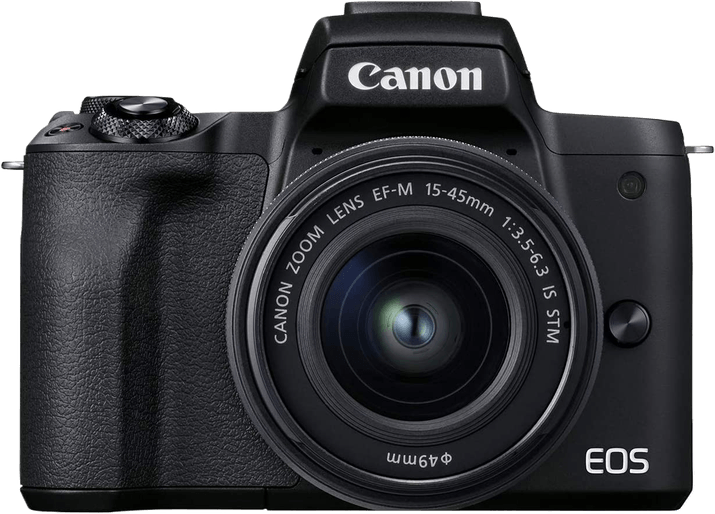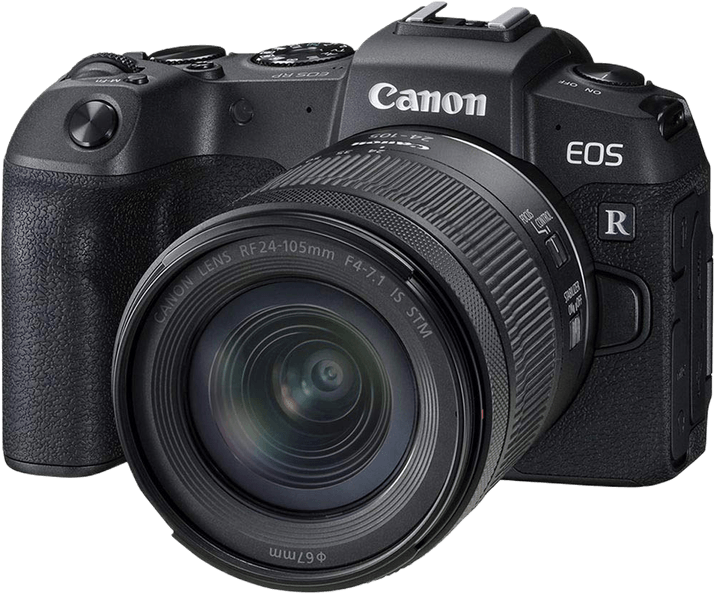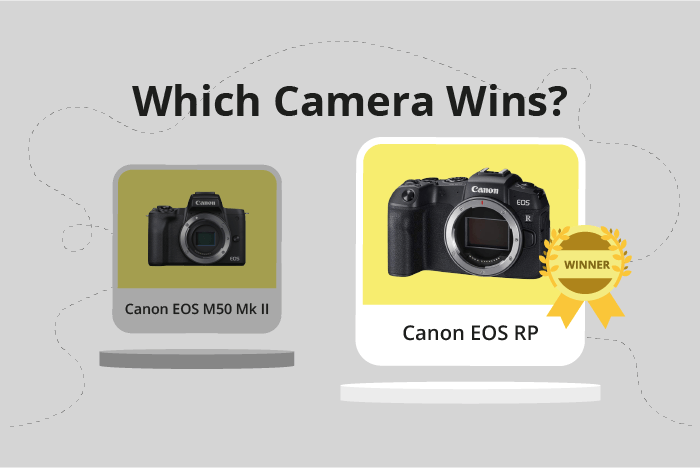Canon EOS M50 Mark II vs EOS RP Comparison
Canon EOS M50 Mark II

Canon EOS RP

The Canon EOS RP comes out on top with a score of 65/100, while the Canon EOS M50 Mark II scores 59/100. Both cameras are mirrorless and were released in 2020 and 2019, respectively. They share similarities in size and weight, with the EOS RP being slightly larger (133 x 85 x 70mm) and heavier (440g) compared to the EOS M50 Mark II (116 x 88 x 59mm and 387g).
The EOS RP’s higher score indicates its superior performance, despite its higher launch price of $1300 compared to the M50 Mark II’s $750. On the other hand, the M50 Mark II offers a more affordable option without sacrificing too much quality.
Taking into account the scores and specifications, the Canon EOS RP is the better camera, but the Canon EOS M50 Mark II is a more budget-friendly choice for those who don’t require top-of-the-line performance.
Canon EOS M50 Mark II vs EOS RP Overview and Optics
The Canon EOS RP outperforms the Canon EOS M50 Mark II in optics with a score of 67/100 compared to 59/100. Both cameras share several specifications, such as a CMOS sensor, Digic 8 processor, and no image stabilization. However, differences in other specifications contribute to the higher score for the EOS RP.
The Canon EOS RP has a 26-megapixel sensor, higher than the 24-megapixel sensor on the EOS M50 Mark II. This allows the EOS RP to capture more detail in images. The EOS RP also boasts a full-frame sensor, compared to the APS-C sensor on the EOS M50 Mark II. A full-frame sensor provides better image quality, particularly in low light situations. The EOS RP’s sensor has a DXOMARK score of 85, significantly higher than the EOS M50 Mark II’s score of 58, which supports the better overall image quality.
The Canon EOS M50 Mark II, however, has a faster shooting speed of 10 frames per second compared to the EOS RP’s 5 frames per second. This makes the EOS M50 Mark II more suitable for capturing fast-moving subjects. Additionally, the EOS M50 Mark II uses a Canon EF-M lens mount, while the EOS RP uses a Canon RF lens mount. The EF-M mount may be more compatible with existing Canon lenses, but the RF mount offers a wider range of new, high-quality lenses.
In comparing optics, the Canon EOS RP is the superior camera due to its higher megapixel count, full-frame sensor, and better DXOMARK score. The EOS M50 Mark II does have advantages in shooting speed and lens compatibility, but these factors do not outweigh the optical superiority of the EOS RP.
Canon EOS M50 Mark II vs EOS RP Video Performance
The Canon EOS M50 Mark II outperforms the Canon EOS RP in video capabilities with a score of 91/100 compared to the RP’s 70/100. Both cameras share certain specifications, such as 4K max video resolution and 3840 x 2160 video dimensions. Additionally, both cameras come with built-in time-lapse functionality, making them suitable for capturing creative video content.
The superior video performance of the M50 Mark II is primarily due to its higher maximum video frame rate of 120fps, compared to the RP’s 25fps. This significant difference allows the M50 Mark II to capture smoother, more detailed videos, particularly when recording fast-moving subjects or creating slow-motion effects. With a higher frame rate, the M50 Mark II is more versatile and better suited for various video applications.
On the other hand, the EOS RP still offers solid video capabilities with its 4K resolution and time-lapse functionality. However, its lower maximum frame rate of 25fps makes it less suitable for capturing fast action or producing slow-motion videos. Despite this limitation, the EOS RP can still produce high-quality video content for casual users or those who do not require high-speed recording.
Comparing the video capabilities of the Canon EOS M50 Mark II and the Canon EOS RP reveals that the M50 Mark II is a better choice for users who prioritize video performance and versatility, due to its higher frame rate. Meanwhile, the RP is a suitable option for those who seek 4K resolution and time-lapse features but do not need the additional advantages provided by a higher frame rate.
Canon EOS M50 Mark II vs EOS RP Features and Benefits
The Canon EOS M50 Mark II and the Canon EOS RP both have a feature score of 70/100. They share many specifications, making them quite similar in terms of features.
Both cameras have a 3-inch screen with a resolution of 1040000 dots, providing clear and sharp image previews. They each have a touchscreen, making it easy to navigate through settings and options. Additionally, both cameras have flip screens, which is useful for capturing images and videos from various angles. Neither camera has GPS, but they both have WIFI and Bluetooth capabilities, allowing for easy connectivity and sharing of files.
Although the Canon EOS M50 Mark II and the Canon EOS RP share the same feature score, there are areas where each camera excels. The M50 Mark II has a smaller and lighter body, making it more portable and easier to carry around for extended periods. This can be a significant advantage for those who value portability and ease of use.
On the other hand, the Canon EOS RP has a full-frame sensor, which provides better image quality and low-light performance compared to the M50 Mark II’s APS-C sensor. This can be an important factor for photographers who prioritize image quality over portability.
To sum up, the Canon EOS M50 Mark II and the Canon EOS RP share many features and have the same score. The M50 Mark II is better for portability, while the EOS RP has superior image quality due to its full-frame sensor. Ultimately, the choice between these cameras depends on the individual photographer’s priorities and preferences.
Canon EOS M50 Mark II vs EOS RP Storage and Battery
The Canon EOS RP outperforms the Canon EOS M50 Mark II in storage and battery with a score of 29/100 compared to 21/100. Both cameras have one memory card slot, and they accept SD, SDHC, and SDXC memory cards. However, the EOS RP is compatible with faster UHS-II cards, while the M50 Mark II supports only UHS-I cards.
The EOS M50 Mark II has a slightly longer battery life of 305 shots, compared to the EOS RP’s 250 shots. Despite this advantage, the EOS RP features USB charging, making it more convenient for on-the-go users. The M50 Mark II lacks this feature.
In terms of battery type, the M50 Mark II uses the LP-E12 battery, while the EOS RP uses the LP-E17 battery. Both have their merits, but the USB charging capability of the EOS RP gives it an edge in this comparison.
Considering the storage and battery aspects, the Canon EOS RP is the better choice due to its compatibility with faster memory cards and USB charging functionality. However, for those prioritizing battery life, the Canon EOS M50 Mark II may still be a suitable option.
Canon EOS M50 Mark II vs EOS RP – Our Verdict
Are you still undecided about which camera is right for you? Have a look at these popular comparisons that feature the Canon EOS M50 Mark II or the Canon EOS RP:

